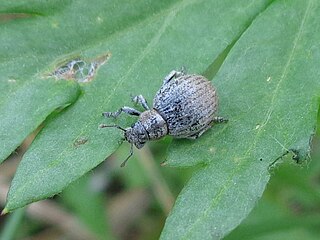Bradyrhynchoides is a genus of broad-nosed weevils in the beetle family Curculionidae. There are at least two described species in Bradyrhynchoides.
Rhigopsis is a genus of broad-nosed weevils in the beetle family Curculionidae. There are at least two described species in Rhigopsis.

Ericydeus is a genus of broad-nosed weevils in the beetle family Curculionidae. There are about 16 described species in Ericydeus.
Pseudorimus is a genus of broad-nosed weevils in the beetle family Curculionidae. There are at least two described species in Pseudorimus.
Colecerus is a genus of broad-nosed weevils in the beetle family Curculionidae. There are about nine described species in Colecerus.
Sapotes is a genus of broad-nosed weevils in the beetle family Curculionidae. There are about five described species in Sapotes.
Mitostylus is a genus of broad-nosed weevils in the beetle family Curculionidae. There are about seven described species in Mitostylus.
Pandeleteinus is a genus of broad-nosed weevils in the beetle family Curculionidae. There are about five described species in Pandeleteinus.
Trachyphloeosoma is a genus of broad-nosed weevils in the beetle family Curculionidae. There are about five described species in Trachyphloeosoma.
Phyxelis is a genus of broad-nosed weevils in the beetle family Curculionidae. There are at least two described species within the genus Phyxelis.
Peritaxia is a genus of broad-nosed weevils in the beetle family Curculionidae. There are about seven described species in Peritaxia.
Agasphaerops is a genus of broad-nosed weevils in the beetle family Curculionidae. There are at least two described species in Agasphaerops.
Hormorus is a genus of broad-nosed weevils in the beetle family Curculionidae. There are at least two described species in Hormorus.
Stenoptochus is a genus of broad-nosed weevils in the beetle family Curculionidae. There are at least two described species in Stenoptochus.
Miloderoides is a genus of broad-nosed weevils in the beetle family Curculionidae. There are at least three described species in Miloderoides.
Rhypodillus is a genus of broad-nosed weevils in the beetle family Curculionidae. There are at least two described species in Rhypodillus.
Dichoxenus is a genus of broad-nosed weevils in the beetle family Curculionidae. There are at least four described species in Dichoxenus.

Philopedon is a genus of broad-nosed weevils in the beetle family Curculionidae. There are about seven described species in Philopedon.
Dysticheus is a genus of broad-nosed weevils in the beetle family Curculionidae. There are at least two described species in Dysticheus.
Agronus is a genus of broad-nosed weevils in the beetle family Curculionidae. There are at least three described species in Agronus.

